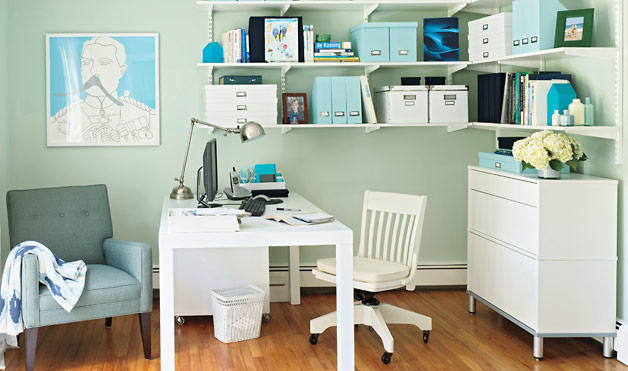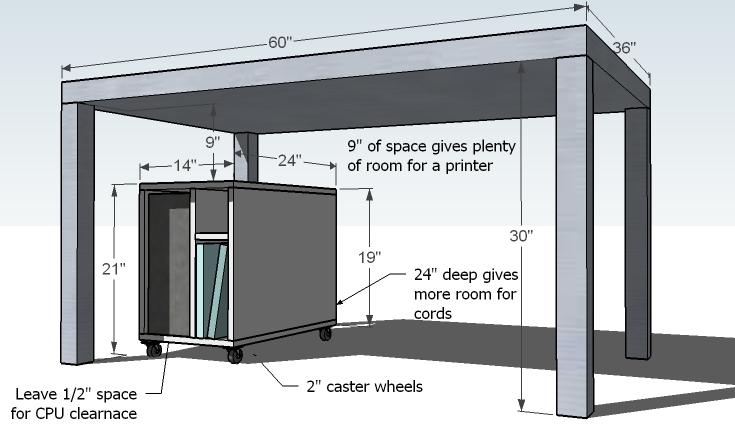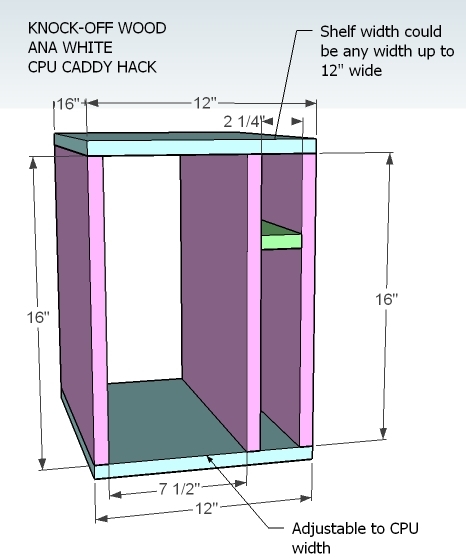
Featured in Woman's Day magazine, this simple CPU Cabinet is easy to build and rolls right under your desk!
Dimensions

Dimensions shown above.
Preparation
Shopping List
For a shopping list, please reference the article in Woman's Day Magazine here.
Cut List
Project Type
Room













Comments
QuackMeHard (not verified)
Thu, 07/29/2010 - 07:24
how exciting! is that the
how exciting! is that the piece that you couldn't show us because it was a commission? Or is that something totally different, because... this doesn't look painted (and i remember you said something about painting...)
Ana White (not verified)
Thu, 07/29/2010 - 07:26
Hi, thank you! This piece
Hi, thank you! This piece actually was painted because the magazine was looking for a matte finish. And yes, I couldn't share :( until it was published. But now it's like I get a day off!
LoriD (not verified)
Thu, 07/29/2010 - 07:29
Congratulations on the
Congratulations on the magazine work! The CPU cabinet - you're right, so simple, but it just never occurred to me to make one!
Kelsey (not verified)
Thu, 07/29/2010 - 07:34
I love how you described your
I love how you described your ideal home. That's exactly what I want. Where the stuff you need has a place to go and the stuff you love has a place to shine. Thanks for sharing your extraordinary talent and helping us all to create the home we desire.
And yeah for being published!!
Alicia (not verified)
Thu, 07/29/2010 - 07:49
Congratulations!What an
Congratulations!What an accomplishment! I love how you make all your designs so easy to read and replicate. I just made the little kids picnic table and am in the process of finishing it before I send you the photos...Love all that you do.
Brandy (not verified)
Thu, 07/29/2010 - 08:04
Congrats! This is so
Congrats! This is so exciting!
lifeofperks.blogspot.com
Amanda Brantley (not verified)
Thu, 07/29/2010 - 08:39
You are amazing, this is just
You are amazing, this is just the beginning. My dad is a woodworker & has awesome equipment but I live 9 hrs away from him. While visiting last week we made my 1st project-cornhole beanbag game. I thought of you and your site the whole time. It was SO FUN! I wish I lived closer so I could go crazy...
Lee and Beth (not verified)
Thu, 07/29/2010 - 10:39
That's so awesome, Ana!
That's so awesome, Ana! Congrats! My husband and I have taken a break from building to sit back, relax, and enjoy our summer. Can't wait to get back into it. You put the joy of building in us for sure!! :)
Hope you and your family are having a great summer!
Beth.
Sarah @ The Ug… (not verified)
Thu, 07/29/2010 - 10:51
Congrats on getting published
Congrats on getting published in the magazine! That's exciting.
I've been wondering lately if I should paint my black printer station that resides in our guest bedroom, but because it's made from melamine, I didn't know if it would be easy to pull off. I guess, instead, I can always make one! Thanks!
Pam @ diy Desi… (not verified)
Thu, 07/29/2010 - 13:24
Congratulations Ana! Oprah's
Congratulations Ana! Oprah's going to be calling next for sure!
olkid (not verified)
Thu, 07/29/2010 - 13:27
This is exactly what I have
This is exactly what I have been looking for! I need a simple CPU cabinet and I looked at Ikea, Target, the big office stores. I couldn't find anything that was right and what I did find was outrageously priced. I'm building it this weekend!
thegeorgetowncottage (not verified)
Thu, 07/29/2010 - 13:43
Woohoo! How cool to see your
Woohoo! How cool to see your name in print. Congrats :)
Jacki (not verified)
Thu, 07/29/2010 - 16:27
congratulations! I got that
congratulations! I got that magazine earlier this week. I didn't realize you made that CPU cover coz I didn't look closer where it's from. Keep up the good work!
Katy (not verified)
Fri, 07/30/2010 - 05:09
Congratulations! Do you have
Congratulations! Do you have a preview issue? Could you tell me the source of those pale blue storage & magazine boxes? I've been looking for that exact shade of blue in office products.
For that matter, could you do plans to (cheaply) make them out of wood so I could build them from wood & paint them blue? Another thing from very thin wood I want to learn about is drawer dividers- I'd like to customize everything in every drawer to exactly sort what I want it to hold (silverware, socks, purses, jewelry, makeup, sweaters, etc.)
Kelly (not verified)
Fri, 07/30/2010 - 10:16
Amen! Well said!Kelly
Amen! Well said!
Kelly
Luke and Katie (not verified)
Fri, 08/13/2010 - 11:05
congrats on being in Woman's
congrats on being in Woman's Day..I was reading the magazine and noticed your name..I was pretty excited for you!